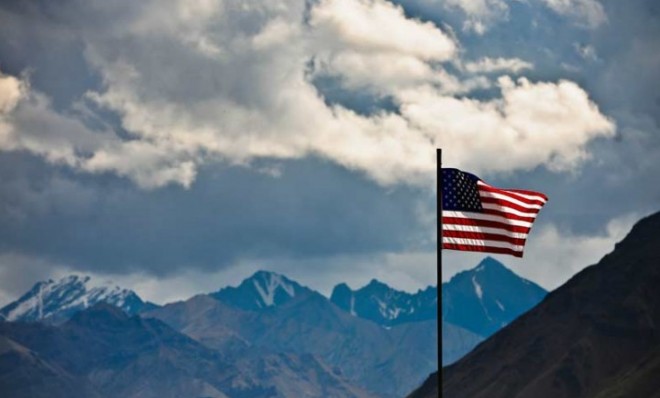6 secessionist movements from throughout U.S. history
A Texas plan to secede is making headlines, and we all know about the Confederate states leaving the Union. But that's not all...


It's not just the Civil War! Throughout American history, there have been many secessionist movements (or secessionist-like movements), with states trying to leave the U.S. and regions trying to leave their states. Here are just a few examples:
1. The Kingdom of Beaver Island
Beaver Island, a small island in Lake Michigan, became the home of Mormon leader James Strang and his followers — called Strangites — in 1848. Two years later, Strang declared himself king of the church — complete with crown, scepter, robe, and a harem of 15 wives. However, most of the island's inhabitants were his followers, so he essentially became King of Beaver Island. The power got to his head, and he began forcing his rule onto the non-believers, causing some violence between the two factions.
The Week
Escape your echo chamber. Get the facts behind the news, plus analysis from multiple perspectives.

Sign up for The Week's Free Newsletters
From our morning news briefing to a weekly Good News Newsletter, get the best of The Week delivered directly to your inbox.
From our morning news briefing to a weekly Good News Newsletter, get the best of The Week delivered directly to your inbox.
In 1856, the USS Michigan pulled into the harbor and invited Strang aboard. As he was walking towards the ship, he was shot in the back by disgruntled followers, who then ran up the gangplank and escaped. Shortly after the assassination, angry mobs from surrounding islands eventually forced the Strangites from their homes, thus ending the short-lived Kingdom of Beaver Island.
2. The State of Superior
Concern over a perceived lack of interest from the Michigan state government, the people of the Upper Peninsula (U.P.), affectionately known as "Yoopers," have been trying to secede and form the State of Superior since at least 1897. The movement gained momentum after 1957 when a bridge connecting the U.P. region to Lower Michigan made it easier for southern "Trolls" (people who live "below the bridge") and Yoopers to mingle. This animosity continued into the mid-1980s, when 20,000 signatures were collected and submitted to the state for a secession request. However, the number was shy of the 36,000 required, and the request subsequently denied.
3. The Great Republic of Rough and Ready
A free daily email with the biggest news stories of the day – and the best features from TheWeek.com
Rough and Ready, California, was a mining town founded in 1849 by the Rough and Ready Company of Wisconsin. As the town's population rapidly exploded to 3,000, lawlessness was on the rise — and the U.S. government was not much help squelching the rampant crime. Additionally, a new federal tax on mining operations added fuel to the region's civil unrest. Seeing little support from Washington, on April 7, 1850, the townspeople voted to secede from the Union.
But just three months later, as the Fourth of July approached, The Great Republic of Rough and Ready wanted to have a celebration (which seems odd considering they were no longer, technically, Americans). When nearby Nevada City wouldn't sell liquor to "foreign miners," it was decided that maybe America wasn't so bad after all.
4. The Conch Republic
In the early-1980s, the U.S. Border Patrol set up a checkpoint at the entrance to the Florida Keys in an effort to stop illegal drugs and immigrants. The time to check everyone's identification at the checkpoint resulted in a 20-mile traffic jam that turned tourists away, thus damaging the economy in the Keys. After numerous legal attempts to have the checkpoint removed, on April 23, 1982, Key West mayor Dennis Wardlow declared the Florida Keys were seceding from the Union.
Moments later, now-Prime Minister Wardlow symbolically declared war on the U.S. by breaking a stale piece of Cuban bread over the head of a man dressed in a U.S. Navy uniform. One minute later, Wardlow turned to the Admiral in charge of the U.S. Naval Base at Key West and surrendered, thus ending the Conch Republic's Civil Rebellion. He then immediately asked for $1 billion in federal aid to help rebuild his war-torn nation's economy.
5. The State of Jefferson
Northern California and southern Oregon have been trying to merge since 1852. The attempts have been met with mixed results, though the "State of Jefferson" movement of 1941 came closest to making it happen. The region felt it was being ignored by their respective state legislatures, so in response the people created the "State of Jefferson Citizen's Committee" to explore the possibilities of secession. To help rally their cause, they developed a state flag made up of a gold miner's pan with two black X's inside, representing the double-cross they felt the Oregon and California state governments had pulled.
On December 4, 1941, Judge John Childs was elected governor of Jefferson in the state's temporary capital of Yreka, CA. But the Japanese bombed Pearl Harbor a few days later and secession was put aside.
6. Alaska
For decades, a well-organized separatist movement has campaigned to turn America's largest state into its own nation. The bitterness dates back to 1958, when Alaska's citizens were given a simple yes-or-no vote on statehood. Many Alaskans felt they were denied more options on the issue, prompting a land developer named Joe Vogler to organize a re-vote that would offer Alaskans four possibilities — remain a territory, become a state, take commonwealth status, or become a separate nation.
Using the vote as his platform, Vogler ran for governor in 1974 — and soon made a habit of it. With colorful slogans such as, "I'm an Alaskan, not an American. I've got no use for America or her damned institutions," Vogler spearheaded the Alaskan Independence Party (AIP), and his campaign has twice topped 5 percent of the vote. More surprisingly, former U.S. interior secretary Wally Hickel got elected governor on the AIP ticket in 1990. Unfortunately for the party, Hickel only ran on the ticket because he lost the Republican primary. Never a supporter of the plebiscite idea, Hickel left the AIP and rejoined the Republicans in 1994.
In 2006, Alaska took part in the first-ever North American Secessionist Convention, joining other groups from Vermont, Hawaii, and the South. As for Vogler, he was murdered in 1993 — reportedly the result of an argument over a business deal. Honoring his wish to never be buried in U.S. soil, Vogler was laid to rest in Canada's Yukon Territory.
More from Mental Floss:
-
 Biggest political break-ups and make-ups of 2025
Biggest political break-ups and make-ups of 2025The Explainer From Trump and Musk to the UK and the EU, Christmas wouldn’t be Christmas without a round-up of the year’s relationship drama
-
 Why 2025 was a pivotal year for AI
Why 2025 was a pivotal year for AITalking Point The ‘hype’ and ‘hopes’ around artificial intelligence are ‘like nothing the world has seen before’
-
 The best drama TV series of 2025
The best drama TV series of 2025the week recommends From the horrors of death to the hive-mind apocalypse, TV is far from out of great ideas